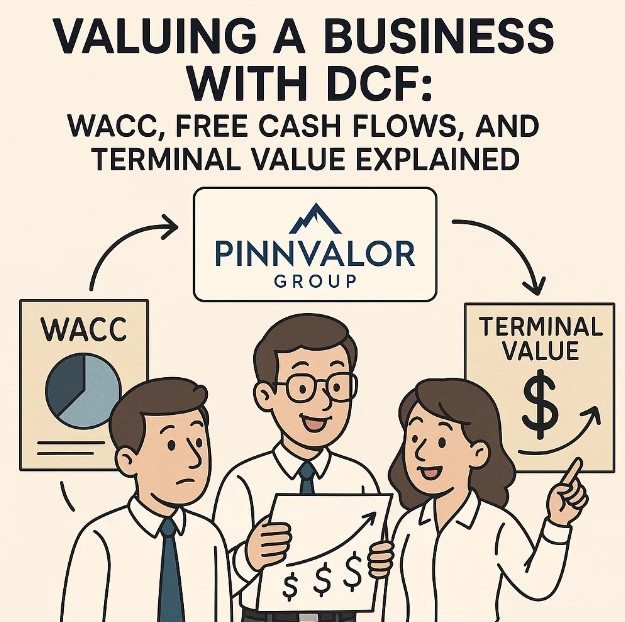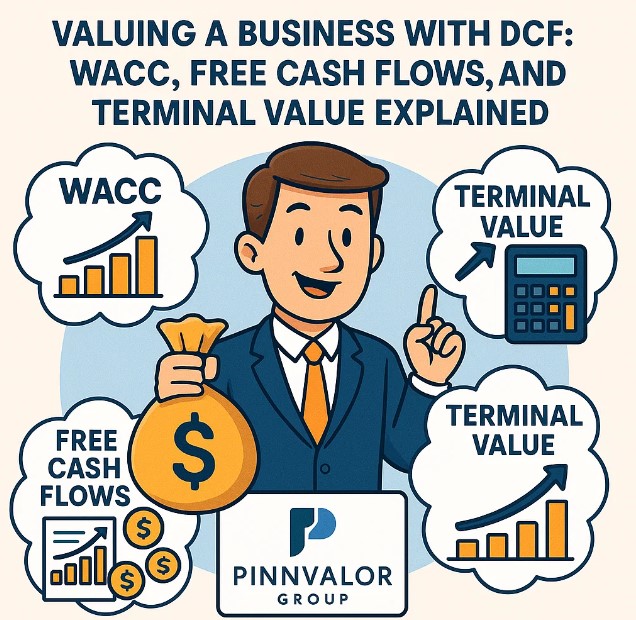
Valuing a Business with DCF: WACC, Free Cash Flows, and Terminal Value Explained
When it comes to business valuation, the Discounted Cash Flow (DCF) method stands out as one of the most rigorous and widely used techniques. Unlike market comparables or asset-based methods, DCF focuses on the intrinsic value of a business by estimating the present value of its future cash flows. In this blog, we’ll break down the key components of the DCF method — Weighted Average Cost of Capital (WACC), Free Cash Flows (FCFs), and Terminal Value — to help you understand how they come together to provide a solid foundation for valuation.
How do future cash flows and the cost of capital unlock the true value of a business today?Do you really understand when and how to recognize revenue under Ind AS 115?
Terminal Value captures the endless potential beyond forecasts, proving that smart valuation isn’t just about numbers, but about foresight and strategy.
What is the Discounted Cash Flow (DCF) Method?
At its core, the DCF method estimates how much a business is worth today based on how much cash it is expected to generate in the future. The fundamental principle is that money available now is worth more than the same amount in the future, due to its earning potential. DCF captures this by discounting future cash flows back to their present value using an appropriate discount rate.
1. Free Cash Flows (FCFs): The Heart of the DCF
Free Cash Flow represents the cash a business generates after covering operating expenses and capital expenditures. This cash is what investors truly care about since it’s available to pay debts, dividends, or reinvest in the company.
How to Calculate Free Cash Flows:
A common formula for unlevered free cash flow (ignoring debt interest) is:
FCF = EBIT × (1 – Tax Rate) + Depreciation & Amortization – Capital Expenditures – Change in Net Working Capital
- EBIT (Earnings Before Interest and Taxes): Profit from operations.
- Tax Rate: Company’s effective tax percentage.
- Depreciation & Amortization: Non-cash charges added back.
- Capital Expenditures (CapEx): Money spent on fixed assets.
- Change in Net Working Capital: Difference between current assets and liabilities needed for daily operations.
By projecting FCFs for several future years, typically 5-10, you build the foundation for the valuation.
2. Weighted Average Cost of Capital (WACC): The Discount Rate
The discount rate in DCF reflects the riskiness of the cash flows — higher risk means higher discount rate, which reduces the present value of future cash flows.
What is WACC?
WACC represents the average rate a company is expected to pay to finance its assets, weighted by the proportion of debt and equity in its capital structure.
WACC Formula:
WACC = (E/V) × Re + (D/V) × Rd × (1 – Tax Rate)
- E: Market value of equity
- D: Market value of debt
- V: Total value (E + D)
- Re: Cost of equity (expected return by shareholders)
- Rd: Cost of debt (interest rate on debt)
WACC balances the costs of equity and debt, reflecting the company’s risk profile and capital structure. This rate is used to discount future FCFs back to present value.
3. Terminal Value: Capturing the Business Beyond the Forecast
Since it’s impractical to forecast cash flows indefinitely, the terminal value estimates the business’s value at the end of the explicit forecast period (e.g., year 5 or 10).
Common Methods to Calculate Terminal Value:
a. Perpetuity Growth Model (Gordon Growth Model):
Terminal Value = FCF in final forecast year × (1 + g) / (WACC – g)
- g: Perpetual growth rate of cash flows (typically aligned with inflation or GDP growth)
b. Exit Multiple Method:
Terminal value is estimated by applying a valuation multiple (e.g., EV/EBITDA) to the final forecast year’s financial metric.
The terminal value usually constitutes a significant portion of the total valuation, so selecting a reasonable growth rate or exit multiple is crucial.

Putting It All Together: Calculating Enterprise Value
- Project Free Cash Flows for a forecast period (5-10 years).
- Calculate Terminal Value at the end of the forecast.
- Discount all cash flows and terminal value back to present value using WACC.
- Sum the present values to arrive at the enterprise value.
Why Use the DCF Method?
- Focus on Fundamentals: It is based on a company’s own cash-generating ability.
- Flexible and Comprehensive: Can be adapted to different industries and companies.
- Risk Adjustment: Incorporates risk through WACC, reflecting business and financial risk.
Challenges & Considerations
- Accurate Projections: Estimating future cash flows requires solid assumptions and understanding of the business.
- Choosing WACC: Determining the correct cost of capital can be complex.
- Terminal Value Sensitivity: Small changes in growth rate assumptions greatly impact valuation.
Conclusion
The Discounted Cash Flow method, anchored by Free Cash Flows, WACC, and Terminal Value, offers a robust framework for valuing businesses based on their intrinsic economic potential. While it requires careful estimation and thoughtful assumptions, mastering this approach equips investors, analysts, and business leaders with a powerful tool to make informed financial decisions.
If you want, I can help you with example calculations or a downloadable DCF model template. Would you like that?
